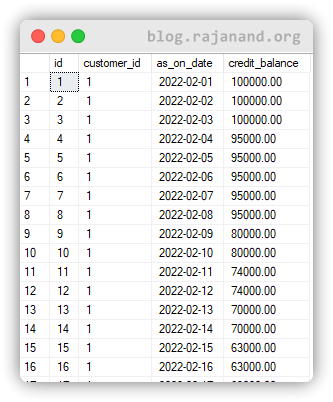How to find out frequent credit card spender in SQL?
SQL interview questions and answers #5
You have joined a bank as their data analyst and you have received the below requirement and need to provide an ad-hoc report to the management.
There is an ETL job which loads the data into the data warehouse with each of the customer's end of day credit card balance. The management wants to find out for each customer
the number of days customers have actively spent.
total amount spent.
Test data
USE TestDB;
GO
DROP TABLE IF EXISTS #CREDIT_BALANCE
CREATE TABLE #CREDIT_BALANCE (
id int not null identity(1,1),
customer_id int,
as_on_date date,
credit_balance decimal(18,2)
)
GO
Insert the data into the table for two customers for every day balance in Feb 2022. For simplicity, we are going to insert just for 1 month data.
--customer 1
INSERT INTO #CREDIT_BALANCE (customer_id, as_on_date, credit_balance) VALUES (1, '2022-02-01', 100000)
INSERT INTO #CREDIT_BALANCE (customer_id, as_on_date, credit_balance) VALUES (1, '2022-02-02', 100000)
INSERT INTO #CREDIT_BALANCE (customer_id, as_on_date, credit_balance) VALUES (1, '2022-02-03', 100000)
INSERT INTO #CREDIT_BALANCE (customer_id, as_on_date, credit_balance) VALUES (1, '2022-02-04', 95000)
INSERT INTO #CREDIT_BALANCE (customer_id, as_on_date, credit_balance) VALUES (1, '2022-02-05', 95000)
INSERT INTO #CREDIT_BALANCE (customer_id, as_on_date, credit_balance) VALUES (1, '2022-02-06', 95000)
INSERT INTO #CREDIT_BALANCE (customer_id, as_on_date, credit_balance) VALUES (1, '2022-02-07', 95000)
INSERT INTO #CREDIT_BALANCE (customer_id, as_on_date, credit_balance) VALUES (1, '2022-02-08', 95000)
INSERT INTO #CREDIT_BALANCE (customer_id, as_on_date, credit_balance) VALUES (1, '2022-02-09', 80000)
INSERT INTO #CREDIT_BALANCE (customer_id, as_on_date, credit_balance) VALUES (1, '2022-02-10', 80000)
INSERT INTO #CREDIT_BALANCE (customer_id, as_on_date, credit_balance) VALUES (1, '2022-02-11', 74000)
INSERT INTO #CREDIT_BALANCE (customer_id, as_on_date, credit_balance) VALUES (1, '2022-02-12', 74000)
INSERT INTO #CREDIT_BALANCE (customer_id, as_on_date, credit_balance) VALUES (1, '2022-02-13', 70000)
INSERT INTO #CREDIT_BALANCE (customer_id, as_on_date, credit_balance) VALUES (1, '2022-02-14', 70000)
INSERT INTO #CREDIT_BALANCE (customer_id, as_on_date, credit_balance) VALUES (1, '2022-02-15', 63000)
INSERT INTO #CREDIT_BALANCE (customer_id, as_on_date, credit_balance) VALUES (1, '2022-02-16', 63000)
INSERT INTO #CREDIT_BALANCE (customer_id, as_on_date, credit_balance) VALUES (1, '2022-02-17', 63000)
INSERT INTO #CREDIT_BALANCE (customer_id, as_on_date, credit_balance) VALUES (1, '2022-02-18', 63000)
INSERT INTO #CREDIT_BALANCE (customer_id, as_on_date, credit_balance) VALUES (1, '2022-02-19', 63000)
INSERT INTO #CREDIT_BALANCE (customer_id, as_on_date, credit_balance) VALUES (1, '2022-02-20', 63000)
INSERT INTO #CREDIT_BALANCE (customer_id, as_on_date, credit_balance) VALUES (1, '2022-02-21', 63000)
INSERT INTO #CREDIT_BALANCE (customer_id, as_on_date, credit_balance) VALUES (1, '2022-02-22', 63000)
INSERT INTO #CREDIT_BALANCE (customer_id, as_on_date, credit_balance) VALUES (1, '2022-02-23', 40000)
INSERT INTO #CREDIT_BALANCE (customer_id, as_on_date, credit_balance) VALUES (1, '2022-02-24', 40000)
INSERT INTO #CREDIT_BALANCE (customer_id, as_on_date, credit_balance) VALUES (1, '2022-02-25', 40000)
INSERT INTO #CREDIT_BALANCE (customer_id, as_on_date, credit_balance) VALUES (1, '2022-02-26', 15000)
INSERT INTO #CREDIT_BALANCE (customer_id, as_on_date, credit_balance) VALUES (1, '2022-02-27', 12000)
INSERT INTO #CREDIT_BALANCE (customer_id, as_on_date, credit_balance) VALUES (1, '2022-02-28', 2000)
--customer 2
INSERT INTO #CREDIT_BALANCE (customer_id, as_on_date, credit_balance) VALUES (2, '2022-02-01', 250000)
INSERT INTO #CREDIT_BALANCE (customer_id, as_on_date, credit_balance) VALUES (2, '2022-02-02', 250000)
INSERT INTO #CREDIT_BALANCE (customer_id, as_on_date, credit_balance) VALUES (2, '2022-02-03', 250000)
INSERT INTO #CREDIT_BALANCE (customer_id, as_on_date, credit_balance) VALUES (2, '2022-02-04', 250000)
INSERT INTO #CREDIT_BALANCE (customer_id, as_on_date, credit_balance) VALUES (2, '2022-02-05', 250000)
INSERT INTO #CREDIT_BALANCE (customer_id, as_on_date, credit_balance) VALUES (2, '2022-02-06', 250000)
INSERT INTO #CREDIT_BALANCE (customer_id, as_on_date, credit_balance) VALUES (2, '2022-02-07', 250000)
INSERT INTO #CREDIT_BALANCE (customer_id, as_on_date, credit_balance) VALUES (2, '2022-02-08', 250000)
INSERT INTO #CREDIT_BALANCE (customer_id, as_on_date, credit_balance) VALUES (2, '2022-02-09', 140000)
INSERT INTO #CREDIT_BALANCE (customer_id, as_on_date, credit_balance) VALUES (2, '2022-02-10', 140000)
INSERT INTO #CREDIT_BALANCE (customer_id, as_on_date, credit_balance) VALUES (2, '2022-02-11', 140000)
INSERT INTO #CREDIT_BALANCE (customer_id, as_on_date, credit_balance) VALUES (2, '2022-02-12', 140000)
INSERT INTO #CREDIT_BALANCE (customer_id, as_on_date, credit_balance) VALUES (2, '2022-02-13', 140000)
INSERT INTO #CREDIT_BALANCE (customer_id, as_on_date, credit_balance) VALUES (2, '2022-02-14', 140000)
INSERT INTO #CREDIT_BALANCE (customer_id, as_on_date, credit_balance) VALUES (2, '2022-02-15', 140000)
INSERT INTO #CREDIT_BALANCE (customer_id, as_on_date, credit_balance) VALUES (2, '2022-02-16', 140000)
INSERT INTO #CREDIT_BALANCE (customer_id, as_on_date, credit_balance) VALUES (2, '2022-02-17', 110000)
INSERT INTO #CREDIT_BALANCE (customer_id, as_on_date, credit_balance) VALUES (2, '2022-02-18', 110000)
INSERT INTO #CREDIT_BALANCE (customer_id, as_on_date, credit_balance) VALUES (2, '2022-02-19', 110000)
INSERT INTO #CREDIT_BALANCE (customer_id, as_on_date, credit_balance) VALUES (2, '2022-02-20', 110000)
INSERT INTO #CREDIT_BALANCE (customer_id, as_on_date, credit_balance) VALUES (2, '2022-02-21', 110000)
INSERT INTO #CREDIT_BALANCE (customer_id, as_on_date, credit_balance) VALUES (2, '2022-02-22', 110000)
INSERT INTO #CREDIT_BALANCE (customer_id, as_on_date, credit_balance) VALUES (2, '2022-02-23', 110000)
INSERT INTO #CREDIT_BALANCE (customer_id, as_on_date, credit_balance) VALUES (2, '2022-02-24', 110000)
INSERT INTO #CREDIT_BALANCE (customer_id, as_on_date, credit_balance) VALUES (2, '2022-02-25', 80000)
INSERT INTO #CREDIT_BALANCE (customer_id, as_on_date, credit_balance) VALUES (2, '2022-02-26', 80000)
INSERT INTO #CREDIT_BALANCE (customer_id, as_on_date, credit_balance) VALUES (2, '2022-02-27', 80000)
INSERT INTO #CREDIT_BALANCE (customer_id, as_on_date, credit_balance) VALUES (2, '2022-02-28', 80000)
GO
This is the sample data we have in the table.

Solution
Implemented this solution considering the readability in mind rather than performance. So there are many CTEs are used to understand each step.
;WITH CTE1 AS (
SELECT id,
customer_id,
as_on_date,
credit_balance,
LAG(credit_balance,1,credit_balance) OVER(PARTITION BY customer_id ORDER BY as_on_date ASC) AS previous_day_credit_balance
FROM #CREDIT_BALANCE
),
CTE2 AS (
SELECT id,
customer_id,
as_on_date,
credit_balance,
CASE WHEN previous_day_credit_balance - credit_balance = 0 THEN 0 ELSE 1 END AS balance_change
FROM CTE1
),
CTE3 AS (
SELECT id,
customer_id,
as_on_date,
credit_balance,
SUM(balance_change) OVER(PARTITION BY customer_id ORDER BY as_on_date) AS balance_group
FROM CTE2
),
CTE4 AS (
SELECT customer_id,
MIN(credit_balance) AS credit_balance
FROM CTE3
GROUP BY customer_id,
balance_group
)
SELECT customer_id,
COUNT(1) AS spending_days_count,
MAX(credit_balance) - MIN(credit_balance) AS amount_spent
FROM CTE4
GROUP BY customer_id
Based on the result, customer 1 has spent on most number of days but customer 2 has spent the most amount.


